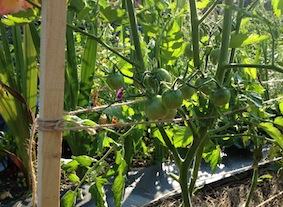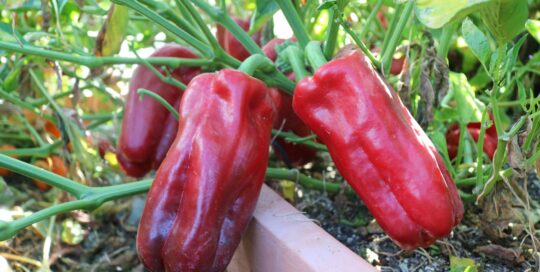Trellis Tomatoes with the Florida Weave
Views: 5476

I procrastinate. It’s what I do. I put something aside to take care of something else and, before I know it, the bills are due tomorrow. Or there are cat-sized dust bunnies on the stairs. Or, the tomato plants are sprawling on the ground with no support. That last example did happen to me this season. I planted 12 tomato plants in a fairly small space in the garden in mid to late May. My reasoning was that I was going to try a new-to-me trellising technique called a Florida weave.
At first, when I heard mention of the Florida weave, to me it sounded more like a hairstyle than a gardening technique. An online search revealed it to be a type of trellising for dense tomato production. A technique that looked like it would work for me and would be simple enough to implement in my own garden.
The Florida Weave Trellis
The term “weave” in the name indicates that weaving is involved. How? Let’s start by explaining the trellis set-up. Picture this: Two 4 or 5 foot sturdy wooden stakes are inserted into the garden ground several (let’s say 5) feet apart. Lines of strong twine are connected from one stake to the other, let’s say at 6 to 8 inch intervals. Young tomato plants are planted 12 to 18 inches apart between the stakes.
Now comes the weaving part. As the tomato grows up, the leader stem and branches are coaxed to one side of the twine, then the other. Looking at one plant, as the tomato grows to meet the first twine it is pushed to the back side of the twine. As it grows up another 8 inches, the stem and branches are pulled to the front side of the second twine. And so on, back then front, as the tomato grows upward. This weaving props up the tomato and stabilizes it.
My Take
My intention was to set up the trellising as soon as I had planted the tomatoes. Didn’t happen. In fact, I waited nearly two months to set up supports for my tomatoes. (Thanks to a cool, extended spring the plants didn’t grow too quickly to begin with.) By this time the plants had filled out substantially and were impossible to weave due to the thickness of their trunks.
Instead I did this: I set up three stakes along my 5 foot row of plants. I strung twine from the first stake, wrapped it around the middle stake, then around the third stake, back to the second and secured the twine at the first stake. The trunks of the four tomato plants were centered between the twine on either side of the stakes. I secured the second length of twine in the same fashion, this time lifting more of the tomato stems and branches up from the ground and securing it between the two sides of twine. I repeated this with a third and fourth length of twine.
Result
The result was four plants that had previously been sprawling on the ground were now held aloft in a single plane. I used the same tools and techniques on two additional rows of tomatoes.
What I have now is this:
– Tomato plants that are held off the ground.
– The plants are easier to prune and remove suckers.
– The developing fruits are held up off the ground and are exposed to more light, which will help them ripen.
– Now that they are better pruned and off the ground, there will be better air circulation. It will also help lower the occurrence of disease.
– Now that I have the stakes I will have no excuse to set up the tomato trellis for a real Florida weave next summer.
Meet Ellen Wells
When you’re raised on a farm, you can’t help but know a thing or two about gardening. Ellen Wells is our expert on edible gardening.…
Ellen's Recent Posts

Pepper Red Impact an All-America Selections Winner






